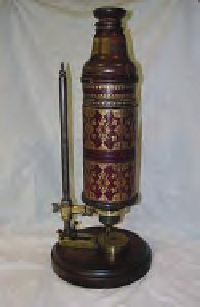Agriculture Reference
In-Depth Information
cell contents disappear, leaving a central cavity or
lumen. Cell walls, in particular those strengthened
by lignin, give support and mechanical strength
to the cell and ultimately to the plant. As well as
acting as a barrier to pathogens, cell walls have
substances embedded in them which signal
attacks and trigger the cell's defences.
Cells and the microscope
The original inventor of the microscope is
hard to establish. Roger Bacon, the English
philosopher and Fransciscan friar, studied
optical lenses in the 1200s and may have
invented the early microscope and telescope.
Others credit Zacharias Jansen, a spectacle
maker in Holland, with inventing the first
microscope in 1590 or Galileo Galilei, the Italian
astronomer, mathematician and philosopher, in
1610. It seems likely that the earliest instruments
were probably developed in the Netherlands
in the early 1600s. In 1665 Robert Hooke,
scientist, inventor, architect (and experimenter
with flying machines), worked on improving
the instrument and examined many natural
objects under his microscopes (Figure 6.3). He
published
Micrographia
, a topic of observations
made using microscopes and telescopes which
included many illustrations. He coined the term
'cell', referring to the resemblance between
the cork cells he studied and the cells which
monks lived in. He estimated that a cubic inch
of cork would contain about 1,259 million cells!
These first microscopes were the familiar optical
microscopes which use light to view the subject;
these are still widely used today in various
forms. They can produce a magnification up to
about 2,000x. Modern electron microscopes,
however, use beams of electrons to illuminate
a subject and produce an image with much
greater magnification up to 10,000,000x.
Scanning electron microscopes produce images
of the surfaces of objects such as the leaf shown
in Figure 10.5 which reveal incredible detail. See
'The Size of Things' on the companion website.
Figure 6.3
A microscope manufactured by Christopher
Cock of London for Robert Hooke (source: Billings
Microscope Collection, USA)
mineral nutrients cross the cell membrane through
a selective process called active transport, which
requires energy (see p. 114) and enables the plant
to take in useful substances whilst rejecting others.
X
The
cytoplasm
, which is largely water, enables
substances dissolved in it to move around the cell
and take part in chemical reactions within it. It has
a network of protein strands which hold the other
cell components in place and prevent them sinking
to the bottom of the cell due to gravity.
Suspended in the cytoplasm are small structures
(organelles), each enclosed within a membrane
and having specialized functions within the cell.
X
The
nucleus
coordinates the activities of the
cell. The long chromosome strands that fi ll the
nucleus are made up of the complex chemical
DNA (deoxyribonucleic acid). In addition to its
ability to produce more of itself for the process
of cell division, DNA manufactures similar RNA
(ribonucleic acid) units, which pass through
the nucleus membrane and attach themselves
to other organelles. In this way, the nucleus
transmits instructions for the assembly of
chemicals within the cell. The coded information
for these processes is found in genes within the
chromosomes.
X
The
mitochondria
release energy, in a controlled
way, by the process of respiration (see p. 116).
The meristems of the stem, root and fl ower,
for example, have cells which are packed with
mitochondria in order to supply energy for rapid cell
division in these areas.
X
Chloroplasts
,
containing the pigment chlorophyll,
are involved in the production of sugar by the
process of photosynthesis (see p. 112) and in its
short-term storage in the form of starch. Starch
grains
are often found in the chloroplasts and
throughout the cytoplasm in living cells.
6
X
The
cell membrane
not only contains the cell
contents but also controls the movement of
substances entering and leaving the cell. Water
uptake takes place through the process of osmosis
(see p. 120) across this selectively permeable
membrane, which allows water to pass but
excludes other substances such as sugars. Some




